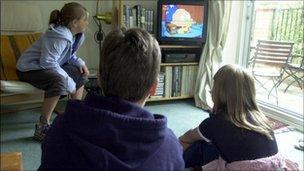Warning over children's multi-screen viewing
- Published

Health campaigns recommend reducing the amount of time children spend watching television
Parents are being warned of a trend among children of watching television while using other interactive devices.
Researchers found children were often "multi-screen viewing" - watching TV while simultaneously using smartphones, laptops or hand-held gaming devices.
Academics at Loughborough and Bristol universities say such habits are linked to obesity, poorer mental well-being and health problems in later life.
The researchers say families need help to limit multi-screen viewing.
The study - I'm on it 24/7 at the moment - questioned 63 10-to-11-year-olds.
The researchers found the children often used a second device to fill in breaks during their entertainment - for example, texting or talking to their friends during advertisements or while they were waiting for computer games to load.
They also found television was used to provide background entertainment while they were doing something else - especially if the programme chosen by their family was considered boring.
One of the study's respondents said: "I'm on my DSi and my laptop. On my DSi I'm on MSN and on my laptop I'm on Facebook and then the TV is on."
Technological advances
Dr Russ Jago, from Bristol University's Centre for Exercise, Nutrition and Health Sciences, said: "There is a shortage of information about the nature of contemporary screen viewing amongst children, especially given the rapid advances in screen-viewing equipment technology and their widespread availability.
"For example, TV programmes are watched on computers, games consoles can be used to surf the internet, smartphones, tablet computers and hand-held games play music, video games provide internet access, and laptop computers can do all of the above."
Dr Jago said health campaigns recommended reducing the amount of time children spend watching TV.
"However, the children in this study often had access to at least five different devices at any one time, and many of these devices were portable.
"This meant that children were able to move the equipment between their bedrooms and family rooms, depending on whether they wanted privacy or company.
"This suggests that we need to work with families to develop strategies to limit the overall time spent multi-screen viewing wherever it occurs within the home."
- Published9 May 2011
- Published4 May 2011